Strategic HRM: Analysis of HealthReach's Challenges and Solutions
VerifiedAdded on 2022/10/01
|6
|1330
|33
Report
AI Summary
This report addresses the human resource challenges faced by HealthReach, a large private healthcare provider in Australia and New Zealand. The report, written from the perspective of a human resource consultant at McBain & Company, analyzes the issues of increasing absenteeism and turnover rates among nursing staff, declining patient care quality, and plummeting job satisfaction and morale. It examines the impact of employing more casual nurses to cut costs. The report incorporates findings from several academic articles on High-Performance Work Systems (HPWS) to offer strategic recommendations for improving employee engagement, job satisfaction, and overall organizational performance. The report explores how HPWS can be implemented within HealthReach to address the issues, and offers recommendations on transformational leadership, appropriate workload, role clarity, staff control, information sharing and extensive training to solve the problems that are currently facing. The report emphasizes the importance of HPWS in healthcare settings and suggests practices such as role clarity, staff control, extensive training, information sharing, and appropriate workload to enhance patient care and organizational performance. References from the articles support the implementation of HPWS and strategic HRM practices at HealthReach.
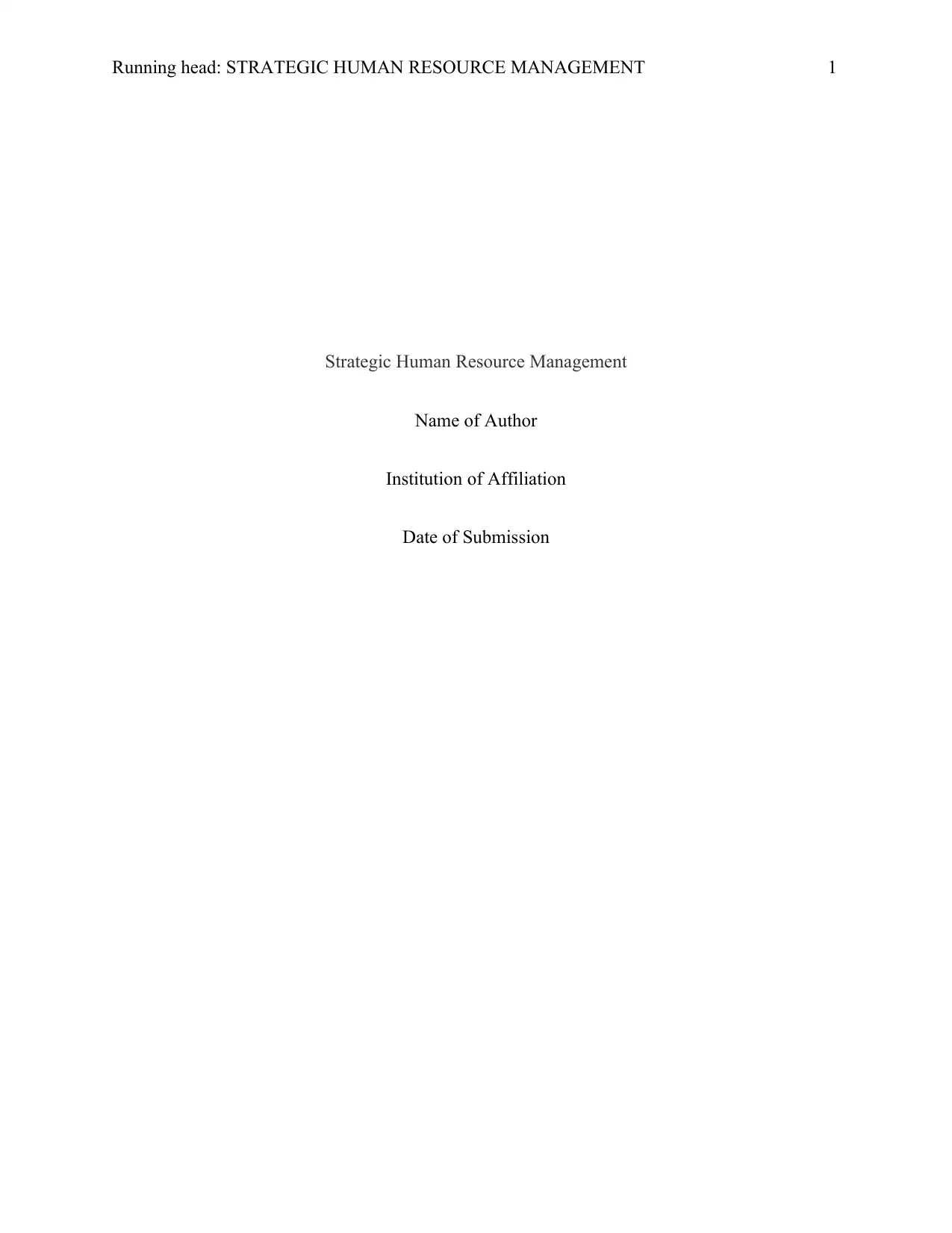
Running head: STRATEGIC HUMAN RESOURCE MANAGEMENT 1
Strategic Human Resource Management
Name of Author
Institution of Affiliation
Date of Submission
Strategic Human Resource Management
Name of Author
Institution of Affiliation
Date of Submission
Paraphrase This Document
Need a fresh take? Get an instant paraphrase of this document with our AI Paraphraser
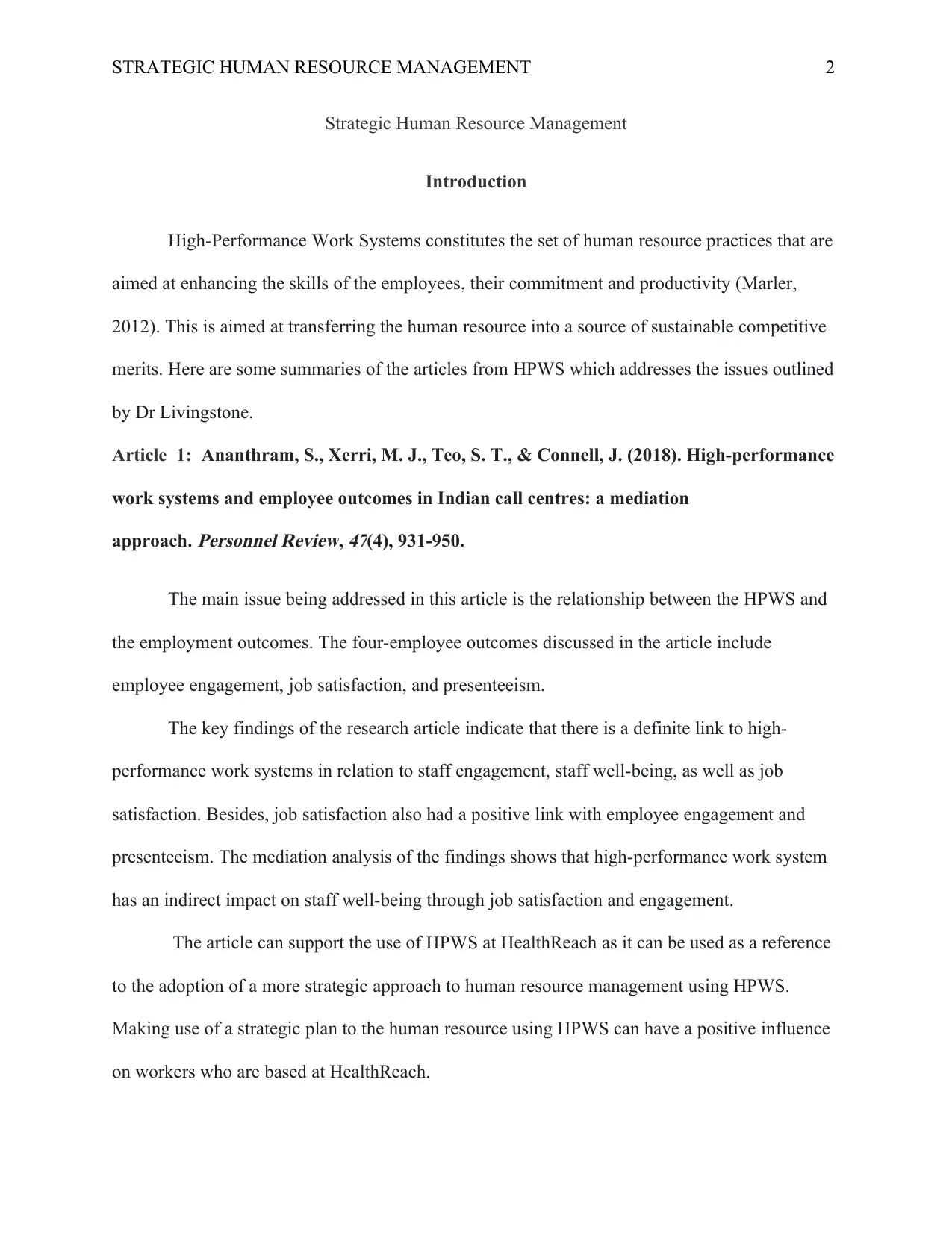
STRATEGIC HUMAN RESOURCE MANAGEMENT 2
Strategic Human Resource Management
Introduction
High-Performance Work Systems constitutes the set of human resource practices that are
aimed at enhancing the skills of the employees, their commitment and productivity (Marler,
2012). This is aimed at transferring the human resource into a source of sustainable competitive
merits. Here are some summaries of the articles from HPWS which addresses the issues outlined
by Dr Livingstone.
Article 1: Ananthram, S., Xerri, M. J., Teo, S. T., & Connell, J. (2018). High-performance
work systems and employee outcomes in Indian call centres: a mediation
approach.
Personnel Review,
47(4), 931-950.
The main issue being addressed in this article is the relationship between the HPWS and
the employment outcomes. The four-employee outcomes discussed in the article include
employee engagement, job satisfaction, and presenteeism.
The key findings of the research article indicate that there is a definite link to high-
performance work systems in relation to staff engagement, staff well-being, as well as job
satisfaction. Besides, job satisfaction also had a positive link with employee engagement and
presenteeism. The mediation analysis of the findings shows that high-performance work system
has an indirect impact on staff well-being through job satisfaction and engagement.
The article can support the use of HPWS at HealthReach as it can be used as a reference
to the adoption of a more strategic approach to human resource management using HPWS.
Making use of a strategic plan to the human resource using HPWS can have a positive influence
on workers who are based at HealthReach.
Strategic Human Resource Management
Introduction
High-Performance Work Systems constitutes the set of human resource practices that are
aimed at enhancing the skills of the employees, their commitment and productivity (Marler,
2012). This is aimed at transferring the human resource into a source of sustainable competitive
merits. Here are some summaries of the articles from HPWS which addresses the issues outlined
by Dr Livingstone.
Article 1: Ananthram, S., Xerri, M. J., Teo, S. T., & Connell, J. (2018). High-performance
work systems and employee outcomes in Indian call centres: a mediation
approach.
Personnel Review,
47(4), 931-950.
The main issue being addressed in this article is the relationship between the HPWS and
the employment outcomes. The four-employee outcomes discussed in the article include
employee engagement, job satisfaction, and presenteeism.
The key findings of the research article indicate that there is a definite link to high-
performance work systems in relation to staff engagement, staff well-being, as well as job
satisfaction. Besides, job satisfaction also had a positive link with employee engagement and
presenteeism. The mediation analysis of the findings shows that high-performance work system
has an indirect impact on staff well-being through job satisfaction and engagement.
The article can support the use of HPWS at HealthReach as it can be used as a reference
to the adoption of a more strategic approach to human resource management using HPWS.
Making use of a strategic plan to the human resource using HPWS can have a positive influence
on workers who are based at HealthReach.
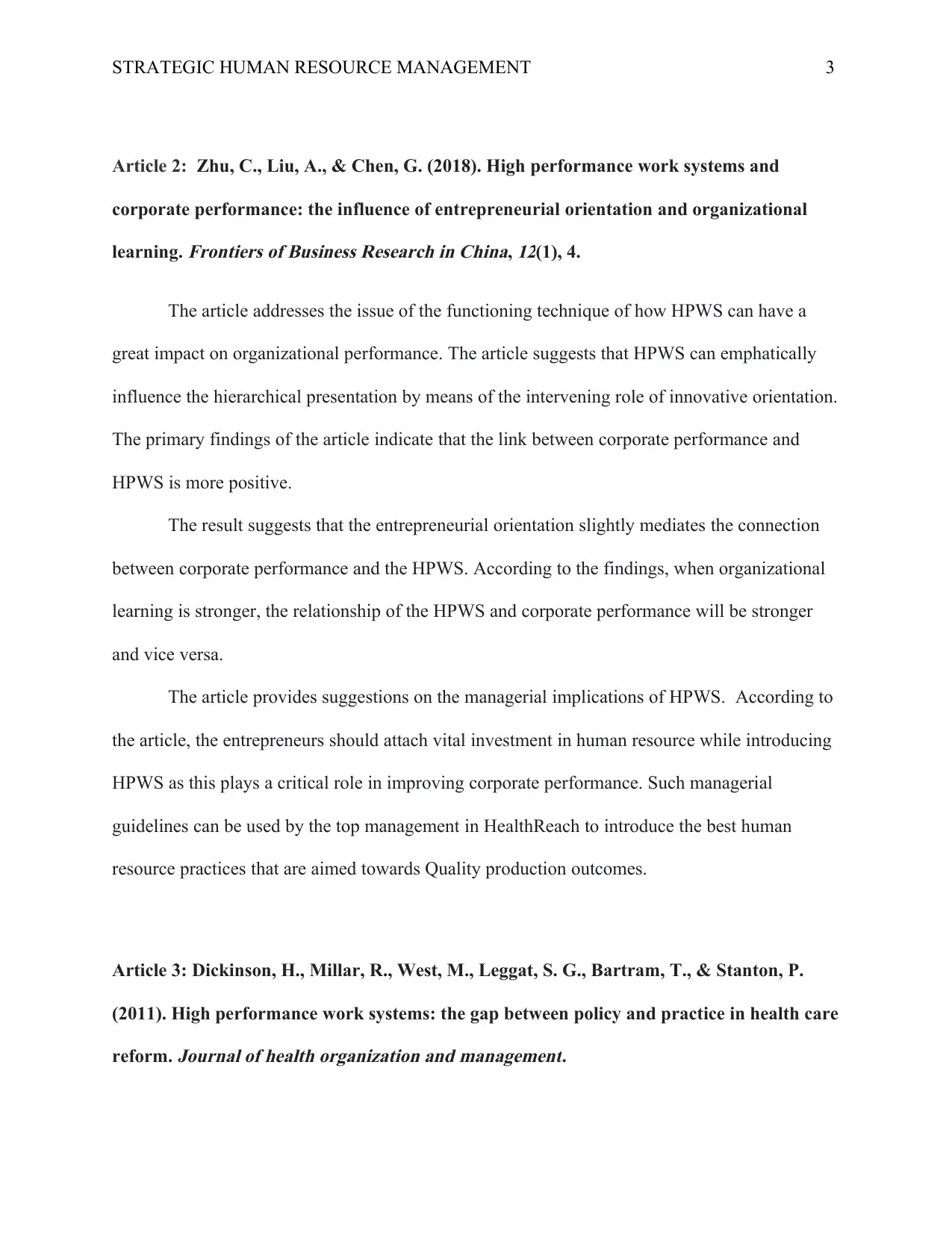
STRATEGIC HUMAN RESOURCE MANAGEMENT 3
Article 2: Zhu, C., Liu, A., & Chen, G. (2018). High performance work systems and
corporate performance: the influence of entrepreneurial orientation and organizational
learning.
Frontiers of Business Research in China,
12(1), 4.
The article addresses the issue of the functioning technique of how HPWS can have a
great impact on organizational performance. The article suggests that HPWS can emphatically
influence the hierarchical presentation by means of the intervening role of innovative orientation.
The primary findings of the article indicate that the link between corporate performance and
HPWS is more positive.
The result suggests that the entrepreneurial orientation slightly mediates the connection
between corporate performance and the HPWS. According to the findings, when organizational
learning is stronger, the relationship of the HPWS and corporate performance will be stronger
and vice versa.
The article provides suggestions on the managerial implications of HPWS. According to
the article, the entrepreneurs should attach vital investment in human resource while introducing
HPWS as this plays a critical role in improving corporate performance. Such managerial
guidelines can be used by the top management in HealthReach to introduce the best human
resource practices that are aimed towards Quality production outcomes.
Article 3: Dickinson, H., Millar, R., West, M., Leggat, S. G., Bartram, T., & Stanton, P.
(2011). High performance work systems: the gap between policy and practice in health care
reform.
Journal of health organization and management.
Article 2: Zhu, C., Liu, A., & Chen, G. (2018). High performance work systems and
corporate performance: the influence of entrepreneurial orientation and organizational
learning.
Frontiers of Business Research in China,
12(1), 4.
The article addresses the issue of the functioning technique of how HPWS can have a
great impact on organizational performance. The article suggests that HPWS can emphatically
influence the hierarchical presentation by means of the intervening role of innovative orientation.
The primary findings of the article indicate that the link between corporate performance and
HPWS is more positive.
The result suggests that the entrepreneurial orientation slightly mediates the connection
between corporate performance and the HPWS. According to the findings, when organizational
learning is stronger, the relationship of the HPWS and corporate performance will be stronger
and vice versa.
The article provides suggestions on the managerial implications of HPWS. According to
the article, the entrepreneurs should attach vital investment in human resource while introducing
HPWS as this plays a critical role in improving corporate performance. Such managerial
guidelines can be used by the top management in HealthReach to introduce the best human
resource practices that are aimed towards Quality production outcomes.
Article 3: Dickinson, H., Millar, R., West, M., Leggat, S. G., Bartram, T., & Stanton, P.
(2011). High performance work systems: the gap between policy and practice in health care
reform.
Journal of health organization and management.
⊘ This is a preview!⊘
Do you want full access?
Subscribe today to unlock all pages.

Trusted by 1+ million students worldwide
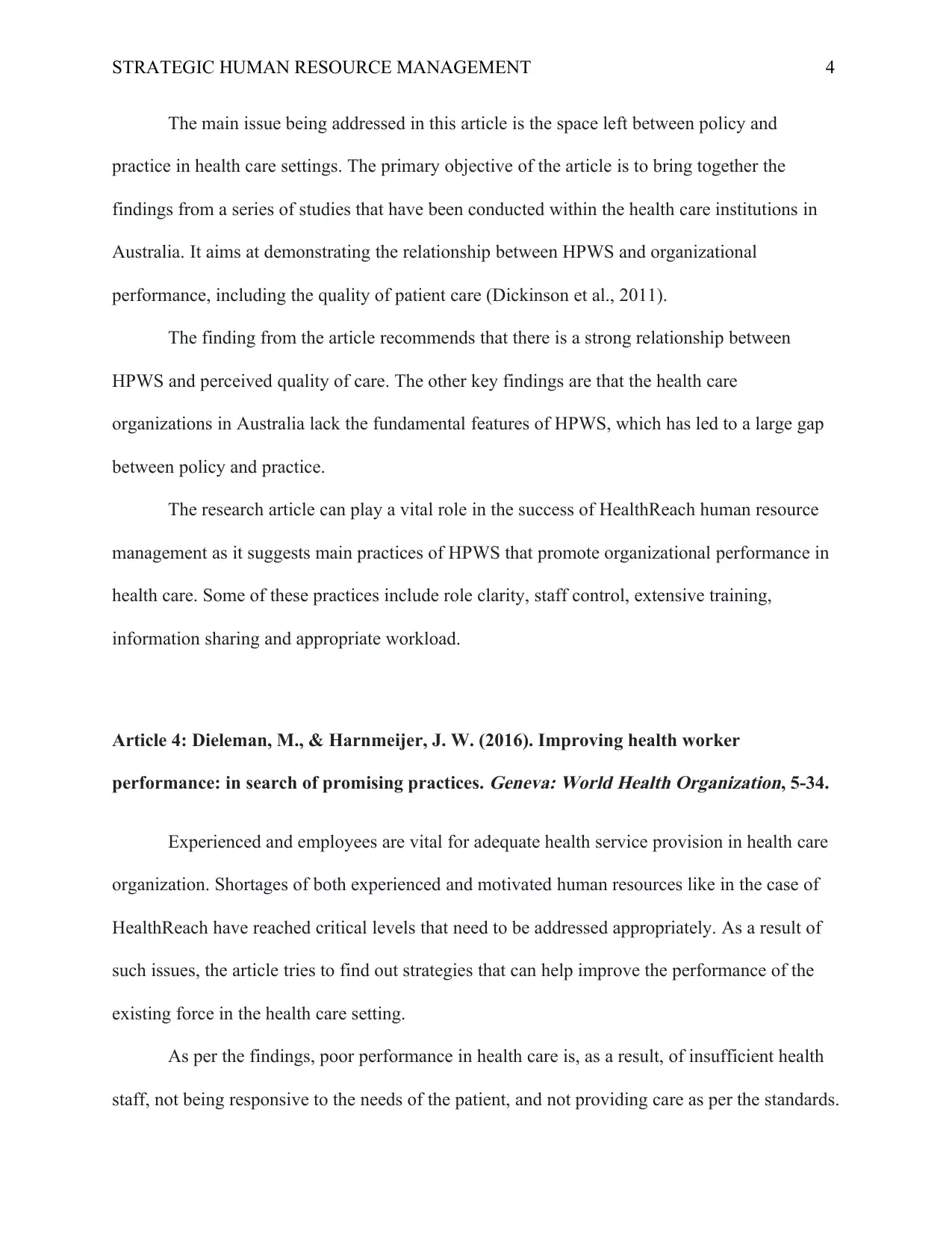
STRATEGIC HUMAN RESOURCE MANAGEMENT 4
The main issue being addressed in this article is the space left between policy and
practice in health care settings. The primary objective of the article is to bring together the
findings from a series of studies that have been conducted within the health care institutions in
Australia. It aims at demonstrating the relationship between HPWS and organizational
performance, including the quality of patient care (Dickinson et al., 2011).
The finding from the article recommends that there is a strong relationship between
HPWS and perceived quality of care. The other key findings are that the health care
organizations in Australia lack the fundamental features of HPWS, which has led to a large gap
between policy and practice.
The research article can play a vital role in the success of HealthReach human resource
management as it suggests main practices of HPWS that promote organizational performance in
health care. Some of these practices include role clarity, staff control, extensive training,
information sharing and appropriate workload.
Article 4: Dieleman, M., & Harnmeijer, J. W. (2016). Improving health worker
performance: in search of promising practices.
Geneva: World Health Organization, 5-34.
Experienced and employees are vital for adequate health service provision in health care
organization. Shortages of both experienced and motivated human resources like in the case of
HealthReach have reached critical levels that need to be addressed appropriately. As a result of
such issues, the article tries to find out strategies that can help improve the performance of the
existing force in the health care setting.
As per the findings, poor performance in health care is, as a result, of insufficient health
staff, not being responsive to the needs of the patient, and not providing care as per the standards.
The main issue being addressed in this article is the space left between policy and
practice in health care settings. The primary objective of the article is to bring together the
findings from a series of studies that have been conducted within the health care institutions in
Australia. It aims at demonstrating the relationship between HPWS and organizational
performance, including the quality of patient care (Dickinson et al., 2011).
The finding from the article recommends that there is a strong relationship between
HPWS and perceived quality of care. The other key findings are that the health care
organizations in Australia lack the fundamental features of HPWS, which has led to a large gap
between policy and practice.
The research article can play a vital role in the success of HealthReach human resource
management as it suggests main practices of HPWS that promote organizational performance in
health care. Some of these practices include role clarity, staff control, extensive training,
information sharing and appropriate workload.
Article 4: Dieleman, M., & Harnmeijer, J. W. (2016). Improving health worker
performance: in search of promising practices.
Geneva: World Health Organization, 5-34.
Experienced and employees are vital for adequate health service provision in health care
organization. Shortages of both experienced and motivated human resources like in the case of
HealthReach have reached critical levels that need to be addressed appropriately. As a result of
such issues, the article tries to find out strategies that can help improve the performance of the
existing force in the health care setting.
As per the findings, poor performance in health care is, as a result, of insufficient health
staff, not being responsive to the needs of the patient, and not providing care as per the standards.
Paraphrase This Document
Need a fresh take? Get an instant paraphrase of this document with our AI Paraphraser
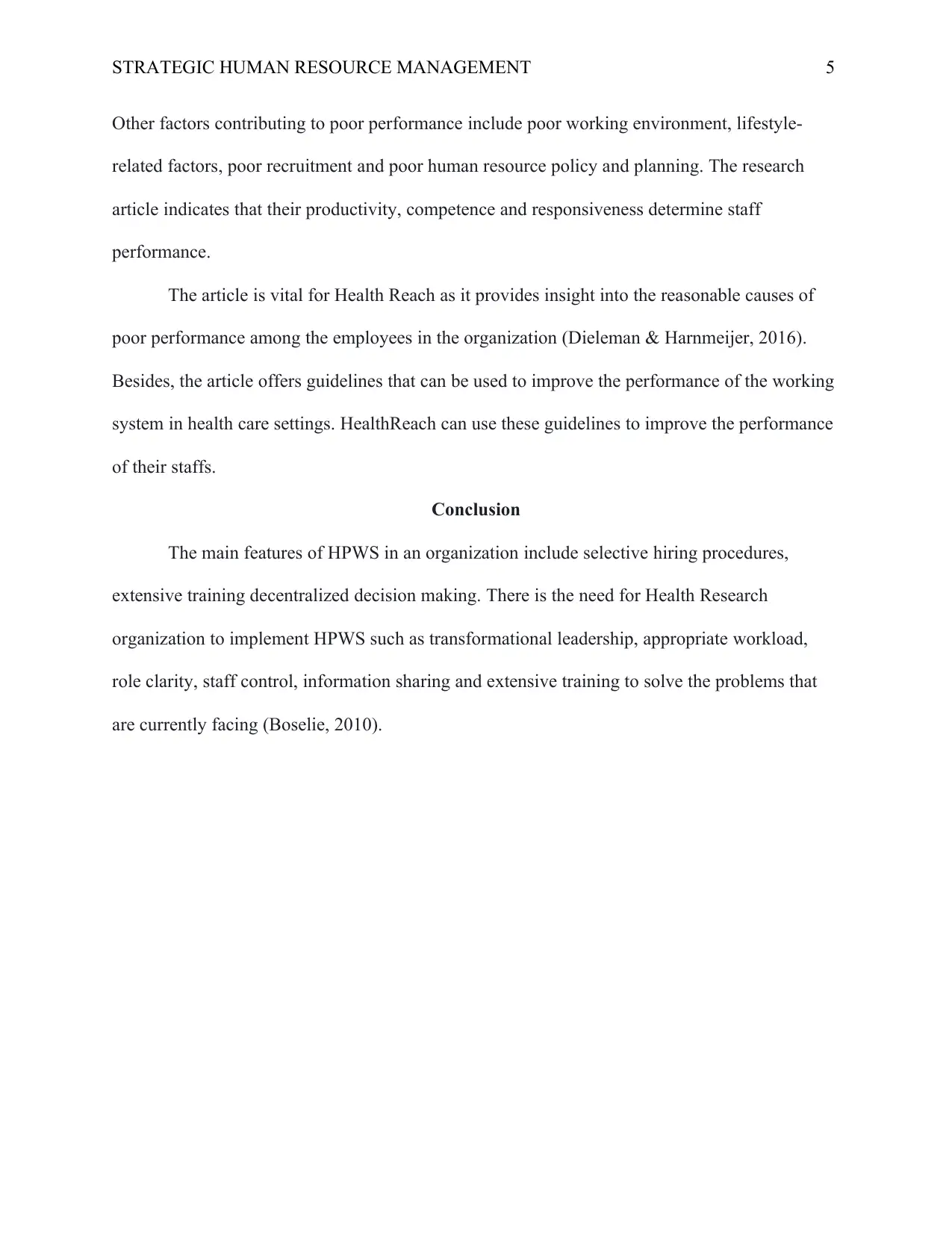
STRATEGIC HUMAN RESOURCE MANAGEMENT 5
Other factors contributing to poor performance include poor working environment, lifestyle-
related factors, poor recruitment and poor human resource policy and planning. The research
article indicates that their productivity, competence and responsiveness determine staff
performance.
The article is vital for Health Reach as it provides insight into the reasonable causes of
poor performance among the employees in the organization (Dieleman & Harnmeijer, 2016).
Besides, the article offers guidelines that can be used to improve the performance of the working
system in health care settings. HealthReach can use these guidelines to improve the performance
of their staffs.
Conclusion
The main features of HPWS in an organization include selective hiring procedures,
extensive training decentralized decision making. There is the need for Health Research
organization to implement HPWS such as transformational leadership, appropriate workload,
role clarity, staff control, information sharing and extensive training to solve the problems that
are currently facing (Boselie, 2010).
Other factors contributing to poor performance include poor working environment, lifestyle-
related factors, poor recruitment and poor human resource policy and planning. The research
article indicates that their productivity, competence and responsiveness determine staff
performance.
The article is vital for Health Reach as it provides insight into the reasonable causes of
poor performance among the employees in the organization (Dieleman & Harnmeijer, 2016).
Besides, the article offers guidelines that can be used to improve the performance of the working
system in health care settings. HealthReach can use these guidelines to improve the performance
of their staffs.
Conclusion
The main features of HPWS in an organization include selective hiring procedures,
extensive training decentralized decision making. There is the need for Health Research
organization to implement HPWS such as transformational leadership, appropriate workload,
role clarity, staff control, information sharing and extensive training to solve the problems that
are currently facing (Boselie, 2010).
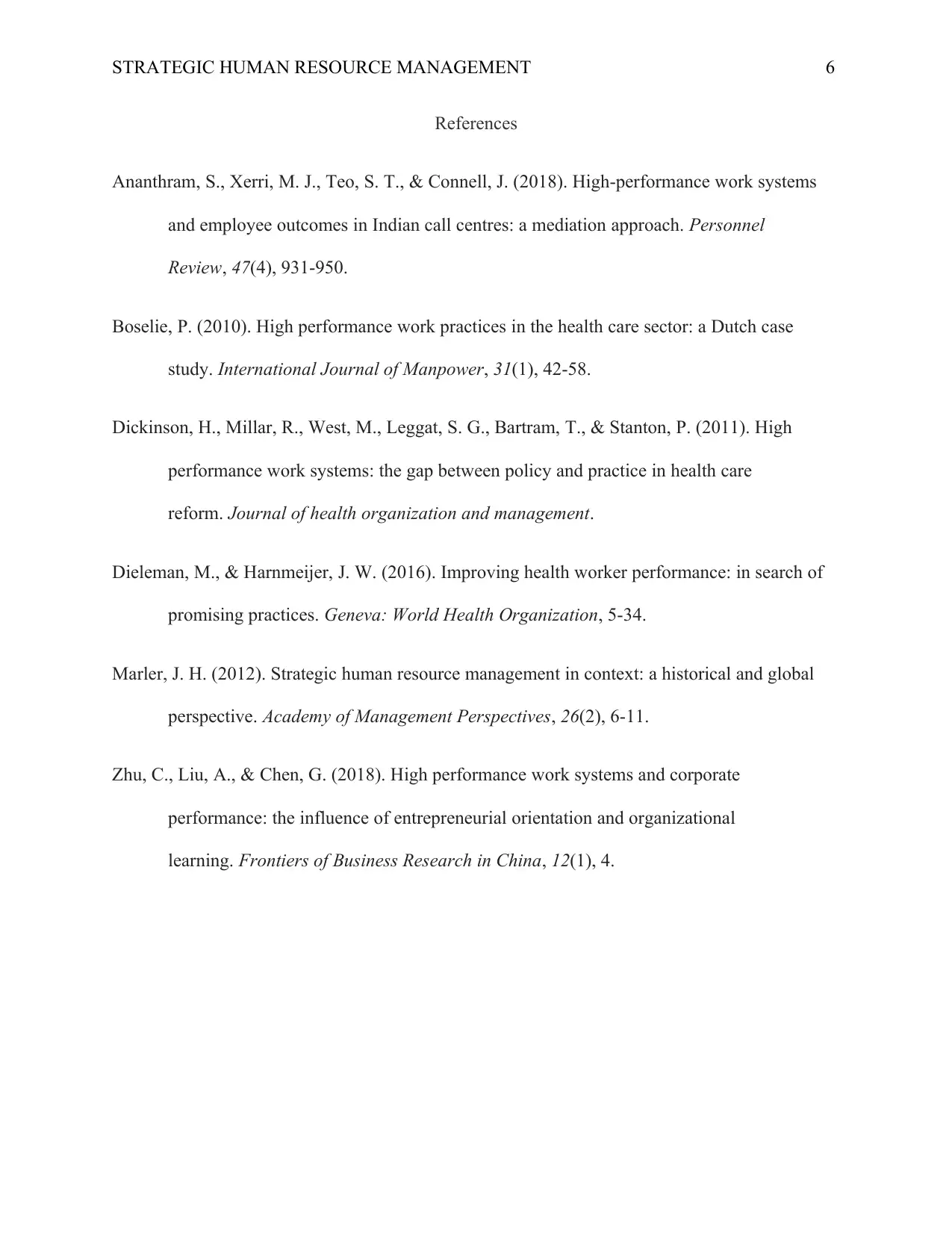
STRATEGIC HUMAN RESOURCE MANAGEMENT 6
References
Ananthram, S., Xerri, M. J., Teo, S. T., & Connell, J. (2018). High-performance work systems
and employee outcomes in Indian call centres: a mediation approach. Personnel
Review, 47(4), 931-950.
Boselie, P. (2010). High performance work practices in the health care sector: a Dutch case
study. International Journal of Manpower, 31(1), 42-58.
Dickinson, H., Millar, R., West, M., Leggat, S. G., Bartram, T., & Stanton, P. (2011). High
performance work systems: the gap between policy and practice in health care
reform. Journal of health organization and management.
Dieleman, M., & Harnmeijer, J. W. (2016). Improving health worker performance: in search of
promising practices. Geneva: World Health Organization, 5-34.
Marler, J. H. (2012). Strategic human resource management in context: a historical and global
perspective. Academy of Management Perspectives, 26(2), 6-11.
Zhu, C., Liu, A., & Chen, G. (2018). High performance work systems and corporate
performance: the influence of entrepreneurial orientation and organizational
learning. Frontiers of Business Research in China, 12(1), 4.
References
Ananthram, S., Xerri, M. J., Teo, S. T., & Connell, J. (2018). High-performance work systems
and employee outcomes in Indian call centres: a mediation approach. Personnel
Review, 47(4), 931-950.
Boselie, P. (2010). High performance work practices in the health care sector: a Dutch case
study. International Journal of Manpower, 31(1), 42-58.
Dickinson, H., Millar, R., West, M., Leggat, S. G., Bartram, T., & Stanton, P. (2011). High
performance work systems: the gap between policy and practice in health care
reform. Journal of health organization and management.
Dieleman, M., & Harnmeijer, J. W. (2016). Improving health worker performance: in search of
promising practices. Geneva: World Health Organization, 5-34.
Marler, J. H. (2012). Strategic human resource management in context: a historical and global
perspective. Academy of Management Perspectives, 26(2), 6-11.
Zhu, C., Liu, A., & Chen, G. (2018). High performance work systems and corporate
performance: the influence of entrepreneurial orientation and organizational
learning. Frontiers of Business Research in China, 12(1), 4.
⊘ This is a preview!⊘
Do you want full access?
Subscribe today to unlock all pages.

Trusted by 1+ million students worldwide
1 out of 6
Related Documents
Your All-in-One AI-Powered Toolkit for Academic Success.
+13062052269
info@desklib.com
Available 24*7 on WhatsApp / Email
![[object Object]](/_next/static/media/star-bottom.7253800d.svg)
Unlock your academic potential
Copyright © 2020–2025 A2Z Services. All Rights Reserved. Developed and managed by ZUCOL.





